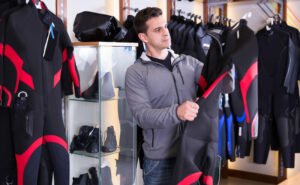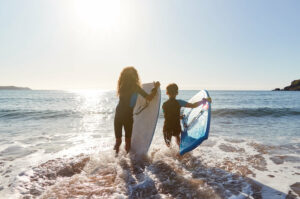Not only is boogie surfing the space-saving and creative answer to small waves – it also offers each and every one a sport, fitted to their individual mood and style. From letting the wave calmly carry you back to the shore to tricks and spins on a competitive level. The surf board’s little brother is full of possibilities.
The back is packed in an instant – leash, fins, wax, rash vest and of course your boogie board. How to choose the right size, the perfect waves and how to get started? We have the answers! So… let’s get down and boogie!
In this article, you will get answers to the following questions:
- What is a boogie board?
- How to prepare a boogie board?
- How to ride a boogie board?
- And what is actually the difference between a boogie board and a bodyboard?
How to ride boogie board – What is boogie boarding?
Boogie boards come in all colors, sizes, and shapes. But the easiest way of picturing a boogie board is imagining a surf board, the soft foam version, and cutting off about a third of its length, starting at the tail, as well as the pointy nose. Neither shape nor material make a big difference now.
Just like a regular surf board, the boogie board consists of a deck, the slick, and rails. While lying with your stomach on the deck, holding on to the side of the foam board, called the rails, the bottom of the board, the slick, carries your body across the water. The slick is made of a more even and harder plastic cover to decrease the friction between board and water for a smoother ride.
The wider the nose of the board, the less speed the rider can gain. If you want to start slowly, you can also choose a wider tail. That will increase the balance and control over the board.
As you can see, it doesn’t require much skill nor preparation, to get the boogie boarding fun started. Yet, there is one aspect, that could diminish your fun. The right size-choice will not only make carrying the board easier, it will also make it easier for the board to carry you.
To check, if you picked the perfect length, bring the board upright next to your body. If the nose reaches the area around your belly button, it is a good fit.
The width measurement can be even less precise. It is only important to ensure a comfortable way into the water. Nothing will destroy your newly won surfer image faster, than carrying the board like an absolute loony. Since you will most likely carry it at your side, you want to pick a size that your arm can easily reach across.
You can already see yourself running in slow motion Baywatch style into the waves? Well, hold your horses and let’s leave the red swimsuit aside for one last moment. Right color and size are essential – no objection – but you are yet not ready to go. But don’t worry, we have got your back and all the information you will need in the following paragraphs.
How to use a boogie board – The preparation
Step 1: Apply wax to your board
Even though classic candle wax might work in an emergency as well, we warmly recommend using a proper surf wax. It is not only easier to apply, but specifically developed to keep your hands and belly from slipping off the board.
How much wax and in which areas of the board one wants it is a topic not even the bodyboarder scene is in consensus on. Start by applying it at the nose and the rails, so the stickiness gives you a better grip when you hold on to the board or try turns. If you feel that your upper body is loosing contact with the board, you can apply some wax to the stomach and hip area of the board.
A few extra hacks:
- Don’t apply the wax in the sun, it will melt! Look for a cooler spot and do it there.
- Don’t trust what you see! Rather test it with your hand. It is hard to slide your hand around once you place it flat on the board? Perfect!
- Don’t apply too much! Taking a bit of wax off is harder than putting on more. A wax scraper can help you to take it off.
Step 2: Pick your outfit
The choice of the optimal outfit depends mainly on the temperatures. But careful! Even if the outside temperatures at the beach are enticingly hot, the water might be surprisingly freezing.
If you intend to spend more time than just for a quick dip into the waves in the water, we highly recommend using a wetsuit. If the air temperature as well as the water temperature are comfortable enough, you can just wear your normal beach wear in combination with a rash guard. It will not only protect your skin from the aggressive UV rays, but will also prevent it from getting rubbed sore on the board.
To make the process of getting out to the waves as effortless as possible, already the first bodyboarders had the idea to make use of fins. Furthermore, the fins have the big advantage of supporting the steering motions. So, they not only make the way in, but also the way out of the water so much more fun.
Step 3: Secure your board
Nothing ruins the mood more than loosing your boogie board out in the ocean. It’s also quite dangerous! Imagine an abandoned board hitting you over the head without any warning.
The leash will most likely come with the board, if not, make sure to get one separately. One end will be connected to the leash plug on the lower deck. The bigger end, consisting of a small Velcro belt, can be either put around the wrist or the biceps. Simply choose the spot, which feels more natural to you.
How to boogie board for beginners
We are almost there. The right outfit picked, sunscreen applied, fins attached and your board secured. We are ready to get serious. But where actually are we going?
Not every beach is boogie boarding material. You will want to avoid crowded spaces, especially if a lot of children are playing in the water. The same goes for areas with lots of fisher boats, rocks or a dangerous current. Pick a spot, where you feel secure and where a lifeguard watches over you. The waves should not be higher than 2 feet and not too strong, since that would make paddling out unnecessarily hard.
1. Getting in the water
Once you selected a spot, you wade out till you are about knee-deep in the ocean. Place your board in front of you, lay down, aligning your hips with the lower end of the board’s tail and start paddling. Make sure, your leash is not tangled up and that you are not blocking another surfer.
The waves tend to break at a specific point, leaving out a path, free of whitewash. Try to orientate your board’s nose along that way.
2. Paddling out
A couple of powerful strokes in combination with waving your fins will carry you out into the ocean. To avoid splashing, try to never raise your fins above sea level. Relax your feet! Especially inexperienced swimmers tend to tense up and end up getting cramps in the sole of their feet.
As for your arms, your shoulder might protest a little at the beginning, but already on the second day it will be better. Stretch your hands and fingers as far forward as possible and let your hands glide along the rails through the water. Not too deep and not too far. Once you reached your hips, pull the hands out and bring them as low as possible above the water back to the front. It helps, if you lift your chest further away from the board.
While you are making your way out, don’t forget to watch out for the waves in front of you. If a breaking wave hits you, keep the board as vertically as possible towards it and hold on to the rails or the nose.
Once you have passed the point break, you can rest your elbows on the board’s deck and enjoy the soft movements of the ocean underneath you.
3. Catching a wave
Do you feel ready for the real deal? Then align your board, facing the beach, and look out for an approaching wave. It might take some time until a good wave comes along. In the meantime, you can watch the other surfers, so you won’t accidentally interfere with their surf path and maybe learn one or two things from them.
When your way to the beach is free and a good wave comes your way, put fins and arms to use and start paddling until you can feel the wave softly lifting the tail of your board. Embrace yourself – the ride is about to start.
4. Riding the wave out
If you timed it right, you will now be able to travel on the white foam of the breaking wave. Place your elbows on the board. Like that, it will be easier to follow the natural direction of the wave. Depending on the elbow, you put more pressure on, your board will adjust its direction. This could come in handy, if a sudden obstacle appears in front of you.
Let the wave carry you as far as you wish and can hold your balance. Congratulations! You can officially call yourself a boogie boarder now.
5. Boogie board tips
Boogie boarding is no quantum physics. But a couple of easy tips and tricks can make the difference from an amateur to a native on the waves. And once you got over the fear and struggles, you can take full advantage of the strength and rules of the ocean.
No. 1: Knowledge is power
Every beach has its peculiarities. When in doubt, it’s advisable to consult the coast guard or the respective website. It will give you a feeling of security and will make reading the direction of the waves much easier once you know about the current of the surf zone in question.
No. 2: Prepare your board
Wax will ensure your hands to find grip on the board, even when the waves try to push you off.
No. 3: Don’t skimp on clothes
Even if the sun is out, and you were sweating at the beach, the water will steal your body’s warmth over time. A wetsuit will prevent you from catching a cold and protect your skin from the sun at the same time.
No. 4: Practice makes prefect
It may take time, but once you have learned, how to read the waves, choose the right ones and the optimal moment to start paddling, and how to position your body correctly, your progress will take a huge step.
No. 5: Don’t overcomplicate things
You don’t have to immediately start at a pro level. Try out smaller waves at first, listen to your body, and figure out for yourself what feels right and what doesn’t. You don’t like the fins? Nobody forces you to wear them! You need little breaks? Take the wave to the beach and get some rest! Boogie boarding is about fun, not discipline.
No. 6: Safety first
One thing that is not up for discussion is wearing a leash! Make sure it is fastened well. Your own and the safety of the people around you depends on it.
No. 7: Learn how to save power
Avoiding strong waves coming your direction on the way out will save you a lot of frustration and tired arms. A useful technique, for example, is the Duck Dive.
Conclusion: How to boogie board in the ocean
The only rule is: Have fun! Boogie boards are a great invention. They are affordable, easy to use, and once you have learned the basics, a whole universe of tricks and individual creative possibilities awaits you. Follow the four easy steps we gathered for you and let your instinct guide you from there on. Wax and rash guard will support your comfort, experience and leash your confidence. With time, you will find the ideal stroking rhythm and can adjust the size of the waves according to your skill level.
FAQ – Most asked questions about boogie boarding
Boogie boarding is a water sport, invented especially for smaller waves. Placing your upper body on the foam board, you can use the power of the water to gather speed and let the waves carry you back to the shore. No need to stand up, no age or skill requirement. A sport for everyone.
The boogie board is merely a supporting floating device for your body. You can rest your body on it, while the wave underneath does all the work.
Easy answer: There is none! Both names stand for the same device. Both are used for surfing without having to stand up. Same shape, same material and same technique.









